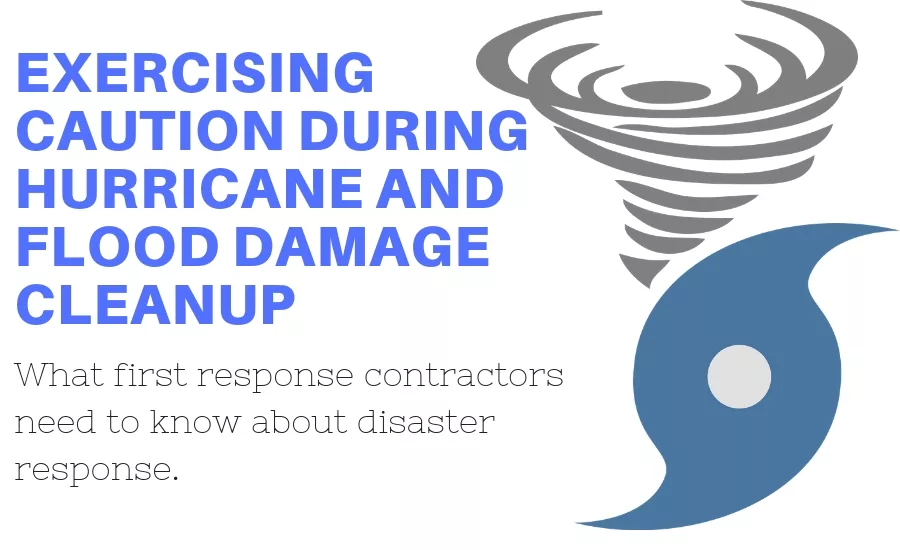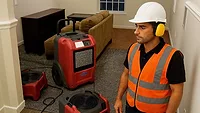Exercising Caution During Hurricane and Flood Damage Cleanup
What first response contractors need to know about disaster response.

The hurricane has passed, the weather is clearing, and the water is receding. That’s when the hazards emerge as first responders and their crews start to enter the area. Fallen trees, downed power lines, flooding and storm debris are some of the visible hazards for crews during clean-up efforts after a hurricane or localized flooding. But there are many hidden dangers!
As cleanup begins in affected areas, workers and residents alike may unknowingly encounter hidden safety and health-compromising conditions, including contaminated water, polluted air, mold, contagious diseases, carbon monoxide, and insects. Being aware of such hazards allows individuals to protect themselves and their crews from dermal, inhalation, and respiratory exposure.
First response contractors (FRCs) need to warn their crews to take proper precautions against these hazards. Risks can be minimized with training, safe work practices, and personal protective equipment (PPE). Industry standards and guidelines as well as Occupational Safety and Health Act (OSHA) Code of Federal Regulations (CFRs) provide solid guidance for personal protection and safety gear and practices.
Only FRCs with proper training, equipment, and experience should conduct recovery and cleanup activities. OSHA recommends that proper measures be taken after a weather-related disaster in these six areas:
- Utilize proper personal protective equipment (PPE) such as gloves, hard hats, hearing and foot protection, and eye protection, and ensure staff is trained in their proper use
- Evaluate all work areas for safety and health hazards
- Assess the stability of structures and walking surfaces
- Ensure proper fall protection for elevated surfaces
- Assume all power and gas lines are live
- Use portable generators, ladders, chainsaws, tools, and other equipment properly
But, before even responding to a hurricane or flooding disaster, it is important that all FRCs consult with a physician regarding required immunizations, such a Hepatitis A and B (some shots maybe a three-step process) and tetanus.
Risks in Floodwaters
Flood and standing water make disease more likely occur. Floodwaters will likely contain sewage, toxic chemicals, blood-borne pathogens, and other potentially infectious materials (OPIM), and hidden sharp objects such as metal or glass. Lurking below these waters might also be snakes and animals that can bite, causing significant health concerns. Thus it’s critical to protect workers from becoming compromised due to these health hazards and to ensure the use of proper PPE, which may include hip waders, rubber boots with steel toes and shank, proper gloves and eye protection, as well as a hard hat.
Risks in the Air
Air pollution after the storm is also a significant health hazard for FRCs. As contaminated waters begin to recede and dry out, mud and silt begins to settle on roads and the interiors and exteriors of buildings. After this mud and silt dries, vehicles and workers entering affected areas stir up this contaminated residue, making it airborne and respirable, which can cause lingering respiratory symptoms—including cough, runny nose, lung infections, and sinus problems. In these situations, PPE that protects from ingestion, inhalation, and dermal contact should be considered. This includes eye protection, appropriate respirators, and may even require disposable coveralls with hood and booties.
Importance of Industry Standards
Industry standards set the criteria or best practices for standard functioning and operations. Standards also disseminate knowledge in industries where products and processes supplied by various providers must interact with one another. Standardization depends on voluntary cooperation among industry, consumers, public authorities, researchers, and other interested parties for the development of technical specifications based on consensus. Not following industry standards can lead to significant risks and liability.
Professionals in the water damage industry widely adhere to ANSI/IICRC S500 - Water Damage Restoration - Fourth Edition: 2015. The forward of this document states: “The IICRC Standard for Professional Water Damage Restoration (IICRC S500) is a procedural standard. It is based on reliable restoration principles, review of available scientific and industry literature and information and practical experience.”
Following Industry Standards
FRCs should carefully review the IICRC S500 standards and related information before responding to major events such major flooding events and disasters. For example, Section 8.1 Worker Safety and Health states (emphasis added):
The regulations referred to in this Standard and Reference Guide are based on United States laws and regulations, but it is understood that other countries generally have comparable health and safety requirements. Restorers shall understand the laws and regulations related to health and safety for the particular country or locale in which they work. Although there are few specific federal, state, provincial and local laws and regulations directly related to water damage restoration and microbial remediation, there are safety and health regulations applicable to businesses that perform such work.
Federal safety and health regulations in the United States that can impact the employees of a restoration business include, but are not limited to the following Occupational Safety and Health Act (OSHA) Standards found in Title 29 of the Code of Federal Regulations (CFR) parts 1910 and 1926:
29 CFR 1910 – General Industry Standards
29 CFR 1926 – Construction Industry Standards
Restoration firms shall comply with applicable sections of both the OSHA General Industry Standards and the Construction Industry Standards.
In addition, the OSHA “General Duty Clause” states that “Each employer: shall furnish to each of his employees employment and a place of employment which are free from recognized hazards that are causing or are likely to cause death or serious physical harm to his employees and shall comply with occupational safety and health standards promulgated under this Act.” (See 29 USC 654, §5. – IICRC S500.) OSHA 29 CFR 1910.132 also requires that employers provide their employees with the necessary PPE to reduce the risk of exposure to chemical, physical, or biological hazards.
These standards make it clear that the FRC employer’s first responsibility should be the health and safety of their crews. Industry standards, and federal laws and guidelines are designed to help accomplish that, and it’s is the responsibility of employers to ensure they stay abreast of changing regulations and standards. While not all trade associations develop standards, many of them do to help their industry improve safety, increase production, reduce cost, enhance quality, and make products and processes are more environmentally friendly. Now, it’s what we do with those standards that makes the difference in how we represent our industry. Stay safe everyone!
References
ANSI/IICRC S500 - Water Damage Restoration - Fourth Edition: 2015. Visit http://publications.iicrc.org/current-standards/s500-2015?qr=1
OSHA maintains a comprehensive website with safety tips to help employers and workers. Visit https://www.osha.gov
Looking for a reprint of this article?
From high-res PDFs to custom plaques, order your copy today!








